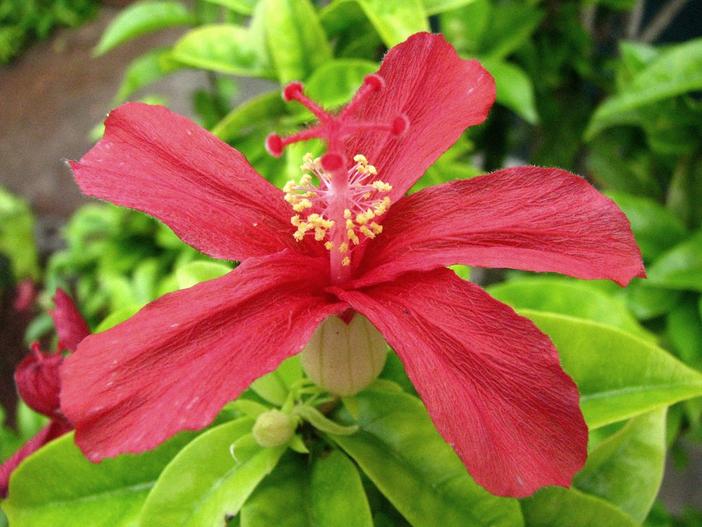Red Kauai Rosemallow
(Hibiscus clayi)
Red Kauai Rosemallow (Hibiscus clayi)
/
/

David Eickhoff
CC BY 2.0
Image By:
David Eickhoff
Recorded By:
Copyright:
CC BY 2.0
Copyright Notice:
Photo by: David Eickhoff | License Type: CC BY 2.0 | License URL: https://creativecommons.org/licenses/by/2.0/ | Uploader: D.Eickhoff | Publisher: Flickr


























Estimated Native Range
Summary
Hibiscus clayi, commonly known as Red Kauai Rosemallow, is an evergreen shrub or small tree endemic to the mesic forests of the Hawaiian Islands, particularly Kauai. It typically grows to a height of 4–8 meters (13–26 ft) when it is tree-like, or remains as a shrub at 40–90 centimeters (16–35 in). The leaves of Hibiscus clayi are medium green, glossy, and can be smooth-edged or slightly toothed at the tip. Its single, axillary flowers are quite showy, with bright to dark red petals, and they bloom throughout the year, contributing to the plant’s ornamental value. The flowers are similar to those of Hibiscus kokio but can be distinguished by their color and specific floral characteristics.
Red Kauai Rosemallow is valued for its continuous, year-round blooming of vibrant red flowers, which add a tropical flair to gardens. It is suitable for use as a specimen plant, in mixed shrub borders, or as part of a conservation garden due to its endangered status. While it prefers full sun, it can tolerate partial shade and requires medium amounts of water with well-draining soil. It is important to protect this plant from strong winds and to provide some shelter if temperatures drop, as it is not frost-tolerant. Due to its rarity, it may be difficult to find in cultivation, and it should be propagated and grown with care to avoid further endangerment.CC BY-SA 4.0
Red Kauai Rosemallow is valued for its continuous, year-round blooming of vibrant red flowers, which add a tropical flair to gardens. It is suitable for use as a specimen plant, in mixed shrub borders, or as part of a conservation garden due to its endangered status. While it prefers full sun, it can tolerate partial shade and requires medium amounts of water with well-draining soil. It is important to protect this plant from strong winds and to provide some shelter if temperatures drop, as it is not frost-tolerant. Due to its rarity, it may be difficult to find in cultivation, and it should be propagated and grown with care to avoid further endangerment.CC BY-SA 4.0
Plant Description
- Plant Type: Tree, Shrub
- Height: 2-15 feet
- Width: 4-6 feet
- Growth Rate: Moderate
- Flower Color: Red
- Flowering Season: Summer
- Leaf Retention: Evergreen
Growth Requirements
- Sun: Full Sun
- Water: Medium
- Drainage: Medium, Fast
Common Uses
Bee Garden, Bird Garden, Butterfly Garden, Hummingbird Garden, Low Maintenance, Showy Flowers
Natural Habitat
Mesic forests of the Hawaiian Islands, particularly Kauai
Other Names
Common Names: Clay’s Hibiscus, Kokiʻo ʻula
Scientific Names: , Hibiscus clayi, Hibiscus newhousei,
GBIF Accepted Name: Hibiscus clayi O.Deg. & I.Deg.